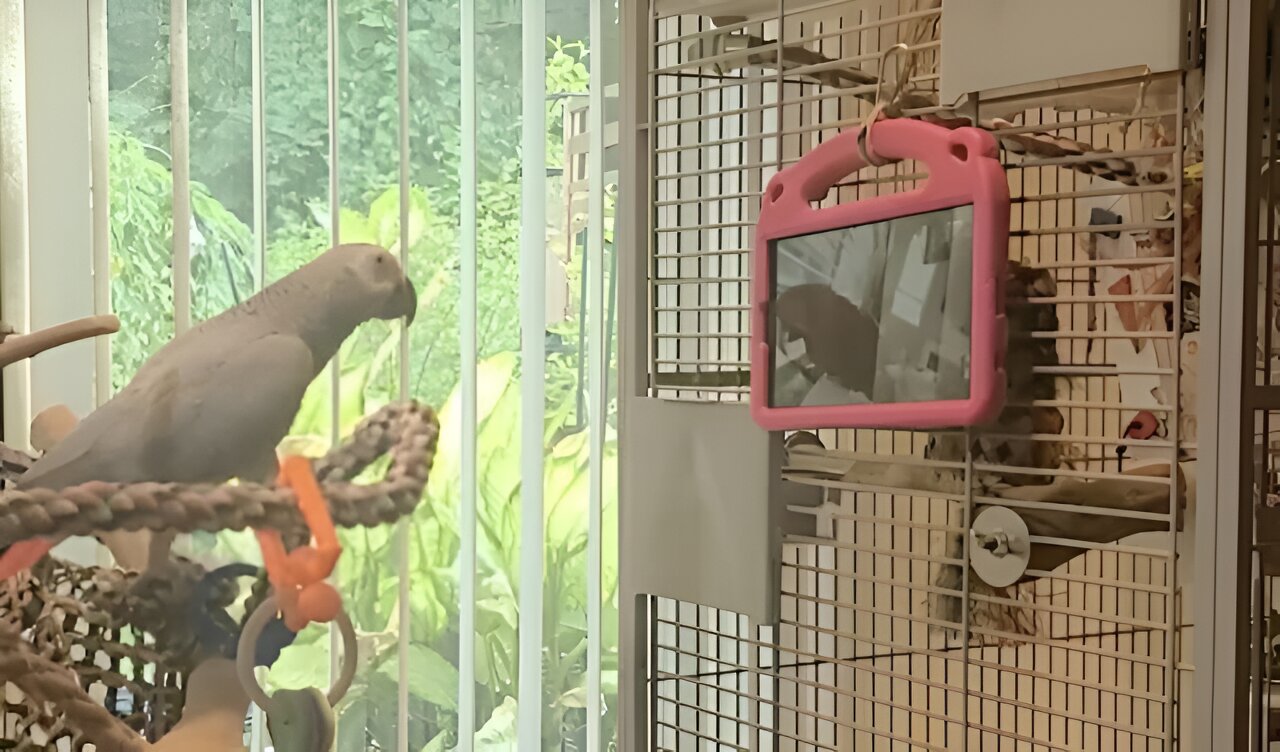We field a torrent of science news updates every week and on Saturday morning, we highlight three or four of them based on the observed preferences of a panel of dogs as shown by the Paired-Stimulus Preference Assessment, a standardized evaluation of preferred stimuli. This week, the dogs selected stories about parrot-to-parrot video calling, loud human noises, and a new neural map of human wakefulness.
Live parrots in your neighborhood want to meet you
Dr. Ilyena Hirskyj-Douglas of the University of Glasgow studies the sociability of parrots and has conducted a number of experiments involving parrot-to-parrot video calling, which parrots really seem to like. Parrots flock together in the wild and are highly sociable, constantly engaging with other parrots. By contrast, parrots in captivity are often completely alone save for their human caretakers.
Dr. Hirskyj-Douglas explores the uses of technology and the internet to improve the lives of pets in the home. In her latest study, she reports that when offered a choice of watching prerecorded video of other parrots or making a live video call to a parrot, the birds strongly preferred the live chat.
Over the six-month span of the study, the birds chose to initiate calls rather than watch videos 65 out of a possible 108 trials. They spent more time engaging with live parrots than they did watching videos and engaged in behaviors like mirroring. Studies like this have the potential to improve the lives of animals and create what Hirskyj-Douglas calls an “animal-centered internet.”
Humans annoy invertebrates
Researchers have known for a while that noise from human activities is disruptive to aquatic life like dolphins and whales, but a new study by University of Denver researchers finds that human-generated noise can mask the harmony of cricket song, with profound effects across 15 species traits.
Among their findings, they report that at a certain noise level, human-generated sounds can reduce the rate of survival to adulthood and affect the number of hatched offspring. The researchers exposed crickets to four levels of sound often encountered in natural settings: silence, 50 decibels, 60 decibels and 70 decibels. At 70 decibels, a level associated with vacuum cleaners and busy streets, survival to adulthood was reduced.
Previous studies have found that human-generated sounds cause changes to birdsong as birds attempt to make themselves heard over traffic, but this is among the first studies to examine human influence on invertebrates as species numbers are collapsing.
Violating personal space: Nanoscale edition
Dysprosium: not the most useful rare-earth element on the periodic table. There are no commodities traders in Chicago making massive bets on dysprosium yields. Still, at ultracold temperatures, it has the highest magnetic strength of all the elements and researchers at MIT recently used it to test the strength of quantum interactions in extremely close proximity. Many quantum interactions are stronger when particles are in close proximity.
Typically, physicists will supercool atoms and push them with lasers to as close as 500 nanometers, a limit set by the wavelength of light. Using a new technique, they placed two layers of dysprosium atoms about 50 nanometers apart, crushing previous records, and observed how proximity affected the element’s traits.
The magnetic interactions between atoms were 1,000 times more powerful than those of dysprosium atoms at 500 nanometers. Enhanced magnetic energy caused heat transfer and synchronized oscillations between the layers. In future experiments, the researchers hope to place atoms into close proximal configurations that could yield the first magnetic quantum gate for quantum computing.
Consciousness mapped
The human brain weighs about 3 pounds and has the consistency of toothpaste, so the fact that we’ve accumulated any knowledge about brain function whatsoever is a real tribute to human endeavor. The interconnections of brain goo are difficult to study physically, but functional MRI has provided new maps of these connections and established a network theory of brain function.
In recent decades, experiments have revealed a series of networks between brain structures to which researchers attribute human behaviors, psychology, sensory perception and physical functions. Researchers at Massachusetts General Hospital and Boston Children’s Hospital have now mapped new brainstem connections that “sustain wakefulness in human consciousness.”
By visualizing brain connections at submillimeter spatial resolution, the researchers identified previously unknown pathways between the brainstem, thalamus, hypothalamus, basal forebrain and the cerebral cortex. They call it a “default ascending arousal network,” which integrates arousal and awareness in human consciousness.
Hannah Kinney, MD, professor emerita at Boston Children’s Hospital and Harvard Medical School, says, “The human brain connections that we identified can be used as a roadmap to better understand a broad range of neurological disorders associated with altered consciousness, from coma, to seizures, to sudden infant death syndrome.”
© 2024 Science X Network
Citation:
Saturday Citations: Parrots on the internet; a map of human wakefulness; the most useless rare-earth element (2024, May 4)
retrieved 4 May 2024
from https://phys.org/news/2024-05-saturday-citations-parrots-internet-human.html
This document is subject to copyright. Apart from any fair dealing for the purpose of private study or research, no
part may be reproduced without the written permission. The content is provided for information purposes only.

